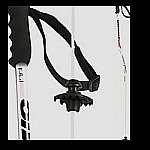|
Ski Pole Selection
Cross country skiing poles act as foreword propulsion thrusters, enabling the skier to gain more speed whilst maintaining balance.
Alpine skiers poles are used for slightly different reasons, mainly to assist with the timimg between turns. The pole acts as a compass or a leverage point around which you transfer your body weight. You are training your brains neural kinetics not only to know how your body position needs to change , but also the timing of the manouvre. The combination of the two makes you a stable fast turner, but then icy surface will quickly scramble all that theory.
Racers in pure high speed disciplines such as Giant ,Super Slalom or speed skiing Will favour curved skis which wrap around the torso in an s-manner in order to reduce air drag, or wind resistance, and help you get airborne even faster!
Ski tourers ,these are the explorers who conquer varied terrain.They will use telescopic poles which can be extended or shortened based on their demands and the gradient of the slope they ski on.
Type-material.
Aluminium poles are most affordable out of the group, durable, and are likely to last for years, as aluminium does not corrode and hence weathering does not set in. They are however a little heavier than its counterparts made out of composite materials. As weight is a deterrent to some professional skiers over time they have lost their popularity. Composite poles have swallowed the market, mainly due to a combination of light almost feathery-weight and reasonable rigidity. They have a greater degree of flex, so if you are into executing goofy turns, or engaging the poles in some weight bearing they are easier to snap. For the vast majority they serve their purpose very well.
Expect to pay more for ski poles made out of composite materials. It is not unusual to pay up to $ 90/ pair for these, as compared to few bucks for aluminium ones.
Length selection – Downhill Skiers.
From ski pole back home.
|





